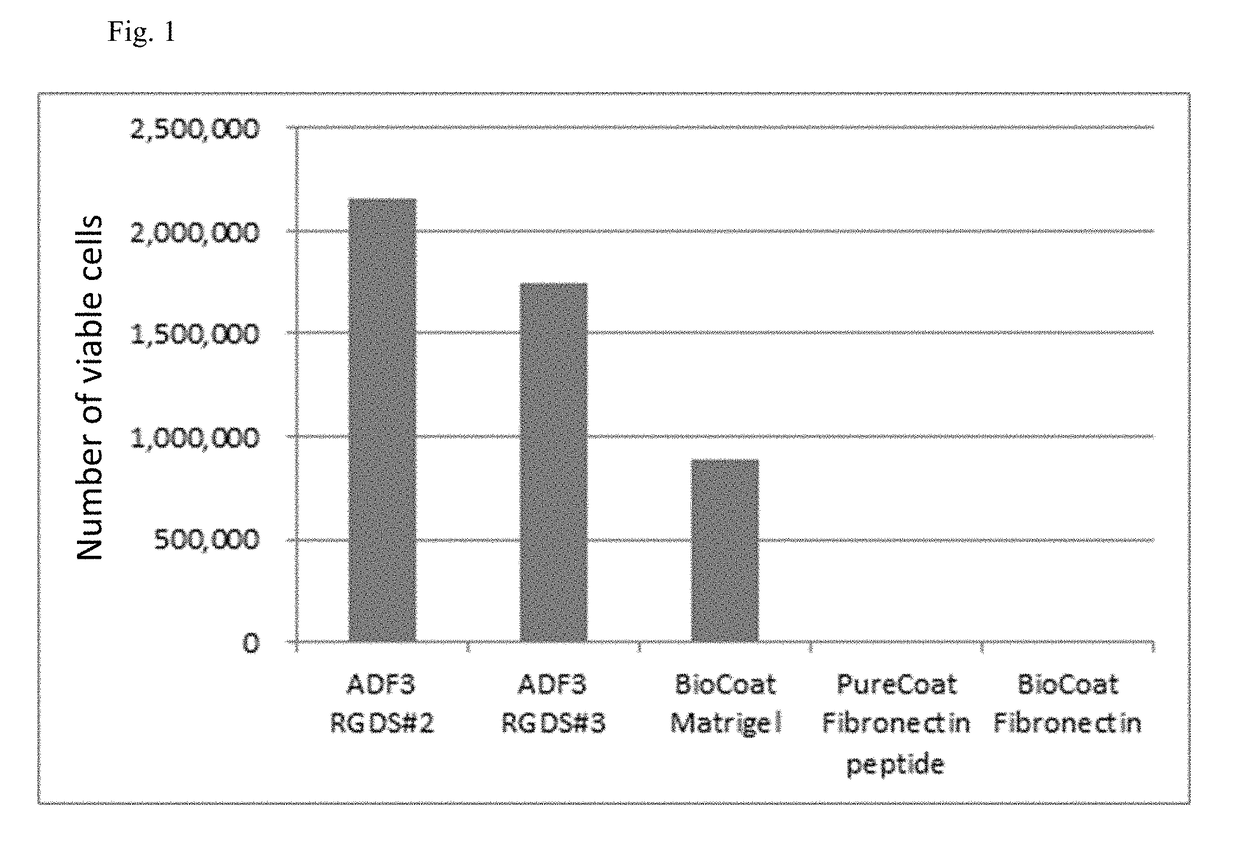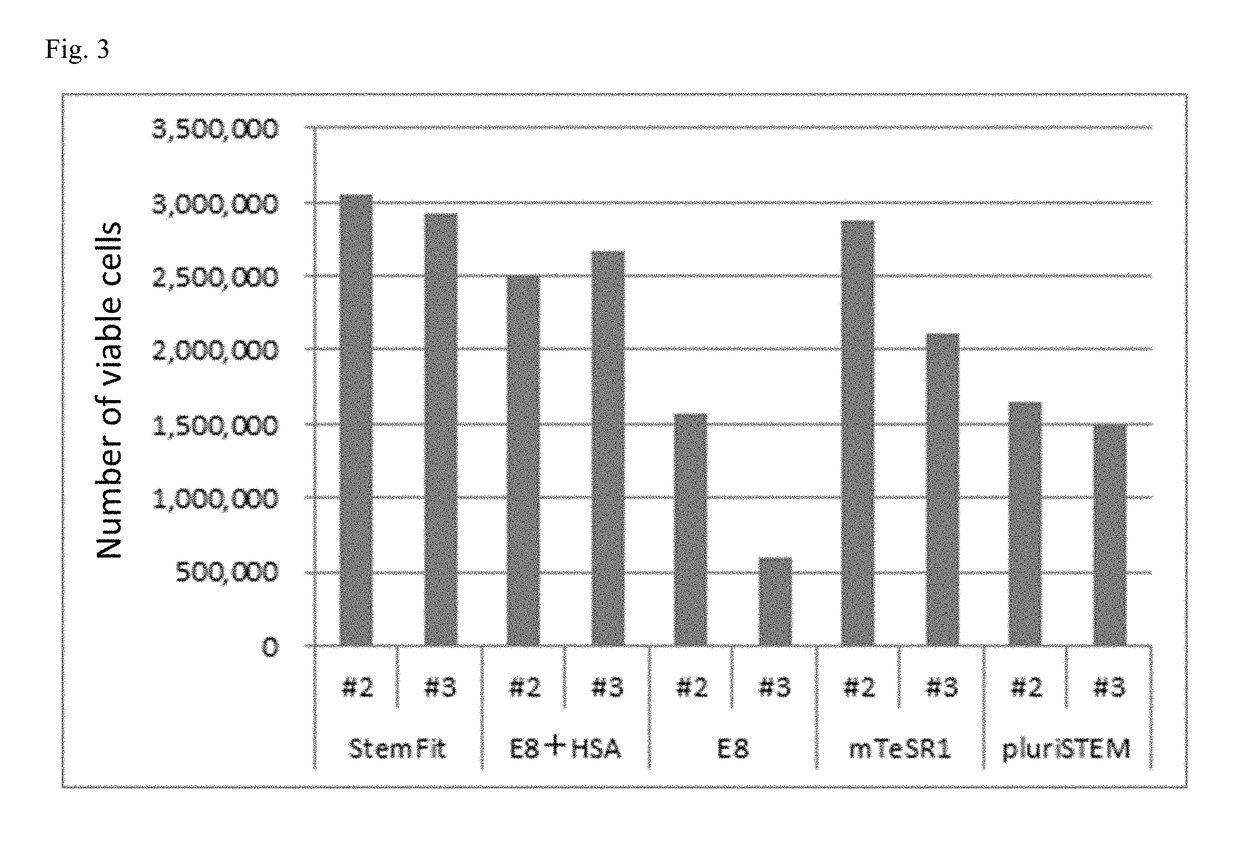Fibroin-Like Protein Variant and Cell Culture Method
a cell culture method and protein technology, applied in the field of fibroin-like protein variant and cell culture method, can solve the problem that stem cells cannot be efficiently cultured, and have not been reported
- Summary
- Abstract
- Description
- Claims
- Application Information
AI Technical Summary
Benefits of technology
Problems solved by technology
Method used
Image
Examples
example 1
Preparation of Cell Adhesion Sequence-Inserted Fibroin-Like Protein (1)
[0177] Construction of Expression Strain for Cell Adhesion Sequence-Inserted Fibroin-Like Protein
[0178]A plasmid pET22b-ADF3 for expressing a gene encoding a fibroin-like protein ADF3 was constructed by digesting pET22b(+) vector (Novagen) with restriction enzymes NdeI and EcoRI, and inserting thereto a totally-synthesized fibroin-like protein gene ADF3 using DNA Ligation Kit (TaKaRa). The nucleotide sequence of the ADF3 gene is shown in SEQ ID NO: 1, and the amino acid sequence of the fibroin-like protein ADF3 encoded by this gene is shown in SEQ ID NO: 2. The ADF3 protein shown in SEQ ID NO: 2 has an His-tag and an HRV3C protease recognition sequence at the N-terminus.
[0179]A plasmid pET22b-ADF3RGDS#2 for expressing a gene encoding a cell adhesion sequence-inserted fibroin-like protein ADF3RGDS#2 was constructed by digesting pET22b(+) vector (Novagen) with restriction enzymes NdeI and EcoRI, and inserting there...
example 2
Preparation of Cell Adhesion Sequence-Inserted Fibroin-Like Protein (2)
[0201] Construction of Expression Strain for Cell Adhesion Sequence-Inserted Fibroin-Like Protein
[0202]A plasmid pET22b-ADF3RGDS#53 for expressing a gene encoding a cell adhesion sequence-inserted fibroin-like protein ADF3RGDS#53 was constructed by digesting pET22b(+) vector (Novagen) with restriction enzymes NdeI and EcoRT, and inserting thereto a totally-synthesized fibroin-like protein gene ADF3RGDS#53 using DNA Ligation Kit (TaKaRa). The nucleotide sequence of the ADF3RGDS#53 gene is shown in SEQ ID NO: 26, and the amino acid sequence of the fibroin-like protein ADF3RGDS#53 encoded by this gene is shown in SEQ ID NO: 27. ADF3RGDS#53 consists of the ADF3 protein shown in SEQ ID NO: 2 except that the HRV3C protease recognition sequence therein was removed and 7 of 12 Ala-non-rich regions therein were each inserted with one unit (i.e. 7 units in total) of a cell adhesion sequence “PQVTRGDVFTM” (SEQ ID NO: 24).
[0...
example 3
Preparation of Cell Adhesion Sequence-Inserted Fibroin-Like Protein (3)
[0220] Construction of Expression Strain for Cell Adhesion Sequence-Inserted Fibroin-Like Protein
[0221]A plasmid pET22b-ADF3RGDS#60 for expressing a gene encoding a cell adhesion sequence-inserted fibroin-like protein ADF3RGDS#60 was constructed by digesting pET22b(+) vector (Novagen) with restriction enzymes NdeI and EcoRI, and inserting thereto a totally-synthesized fibroin-like protein gene ADF3RGDS#60 using DNA Ligation Kit (TaKaRa). The nucleotide sequence of the ADF3RGDS#60 gene is shown in SEQ ID NO: 35, and the amino acid sequence of the fibroin-like protein ADF3RGDS#60 encoded by this gene is shown in SEQ ID NO: 36. ADF3RGDS#60 consists of the ADF3 protein shown in SEQ ID NO: 2 except that 7 of 12 Ala-non-rich regions therein were each inserted with one unit (i.e. 7 units in total) of a cell adhesion sequence “GRGDNP” (SEQ ID NO: 30).
[0222]A plasmid pET22b-ADF3RGDS#65 for expressing a gene encoding a cel...
PUM
| Property | Measurement | Unit |
|---|---|---|
| Fraction | aaaaa | aaaaa |
| Fraction | aaaaa | aaaaa |
| Fraction | aaaaa | aaaaa |
Abstract
Description
Claims
Application Information
 Login to View More
Login to View More - R&D
- Intellectual Property
- Life Sciences
- Materials
- Tech Scout
- Unparalleled Data Quality
- Higher Quality Content
- 60% Fewer Hallucinations
Browse by: Latest US Patents, China's latest patents, Technical Efficacy Thesaurus, Application Domain, Technology Topic, Popular Technical Reports.
© 2025 PatSnap. All rights reserved.Legal|Privacy policy|Modern Slavery Act Transparency Statement|Sitemap|About US| Contact US: help@patsnap.com



